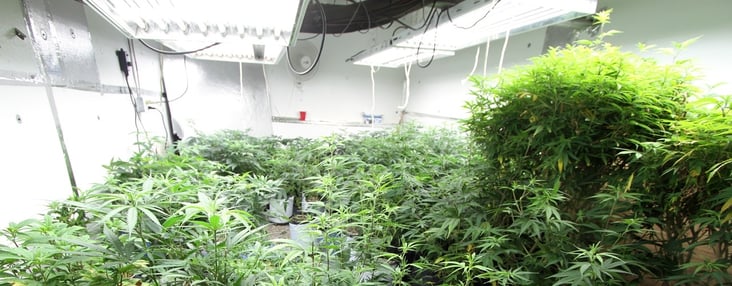
Advanced energy is big business, representing $200 billion in revenues in the U.S. alone—on par with the pharmaceutical industry – and growing. This week the news is all about the green, and we don’t mean eco-friendly. We’re talking greenbacks. We have stories of financing models for energy storage and big-bucks deals for AEE member companies. Plus, the energy challenges of growing a different kind of green—marijuana.
Nearly everyone agrees that energy storage is key to bringing the grid into the 21st century, handling periods of peak demand, and accommodating variable generation resources like wind and solar. But the evidence is piling up.
Heck, just last month, Massachusetts released a study that looks at the costs and, more importantly, the benefits of energy storage, laying the groundwork for a future energy storage mandate to follow up on the state’s landmark energy legislation. Energy storage, however, is running into the same problem many other energy technologies face—upfront costs. We saw it with solar before some certain financing models became industry standards (the latest of which, a partnership between SolarCity and Citi, made headlines this week). But Greentech Media says that energy storage financing is “coming into its own.”
GTM’s Julian Spector describes a sea change in the industry: this year alone, Advanced Microgrid Systems, Tabuchi Electric, Sharp, and AEE member Stem raised money for project financing. In the case of Sharp and Tabuchi Electric, the money will go directly into solar+storage systems, which, as we all know, go together like peanut butter and chocolate. Add that to the existing SolarCity/Tesla Powerwall systems, which can be leased for $0.26 per kWh in Hawaii, and we see a trend of energy storage systems becoming more affordable than ever.
That doesn’t mean energy storage is out of the financial woods. “There’s no track record of five or more years of real returns out of these systems,” said Carl Mansfield, the general manager of Sharp’s energy storage division. “Bankability for storage is still a challenge.”
Upfront costs versus operating savings is the classic problem in energy efficiency, as well. But there is another way that wasteful energy use may be penny-wise and pound-foolish – workplaces that are too cold or too hot for comfort. Or, as Utility Dive put it bluntly in a headline this week, “Commercial buildings spend millions making people uncomfortable.”
Now, I don’t need to tell you that office buildings are uncomfortable—chances are, you’re too hot or too cold right now, in the office you’re sitting in. But energy mismanagement in offices complexes is more than a minor annoyance. In a new study, researchers at the Rochester Institute of Technology (RIT) estimate that commercial buildings are spending $600 million more than they need to on heating and cooling, while 40% of workers in those buildings report being dissatisfied with the temperature.
See, when I left the door open in the wintertime as a kid, my mom would ask if I was raised in a barn. So I say to these property managers: surely you weren’t all raised in barns, right? If not, RIT has some suggestions for technologies that would be the equivalent of closing the front door: smart thermostats, thermal storage, and other advanced energy technologies.
Meanwhile, AEE members continue to make deals that are changing the way we use energy all over the map. Ice Energy announced it would launch residential thermal storage in early 2017, providing a better way to cool houses. Gridco announced that it had closed a round of funding, raising $12 million to advance its next-generation grid management tools. General Electric announced that its battery and gas turbine hybrid is “ready for global prime time.” And member company Microsoft helped us build a tool that could just be the next big thing in tracking energy policy: check it out.
Finally, with more states legalizing marijuana grow operations, or considering ballot questions to do so, pot energy management is heating up. Greentech Media reported recently that grow operations could “rival data center energy use.” It’s no joke: last year we reported on a startling growth in pot-related power outages. Now that marijuana is legal in some states, whether for medical or recreational purposes, pot-related electricity use is growing. A new study from EQ Research (entitled A Chronic Problem—on this subject, the puns are hard to avoid) details just how much. Indoor growth operations may already represent as much as 1% of U.S. electricity demand. Currently, data centers represent about 2%.
In the city of Denver, Katherine Tweed reports, indoor growth operations account for more than 2% of electricity use. Within 20 years, she writes, Washington state “expects marijuana energy use to exceed the energy draw of electric vehicles.” In fact, in 2014 we reported that the three major sources of load growth in the Pacific Northwest are EVs, data centers, and marijuana grow operations.
For the moment, much like an RA smelling a little too much incense coming from the bathroom, utilities are more or less looking the other way. After all, it’s still illegal under federal law to grow marijuana, and utilities don’t want to get in trouble with the feds. But as this crop’s energy demands grow, it could just be utilities leaving the barn door open.
Keep up-to-date with all advanced energy news by subscribing to AEE Weekly. Click below!
Featured image courtesy of Rusty Blazenhoff (not joking) and used under a Creative Commons license.
